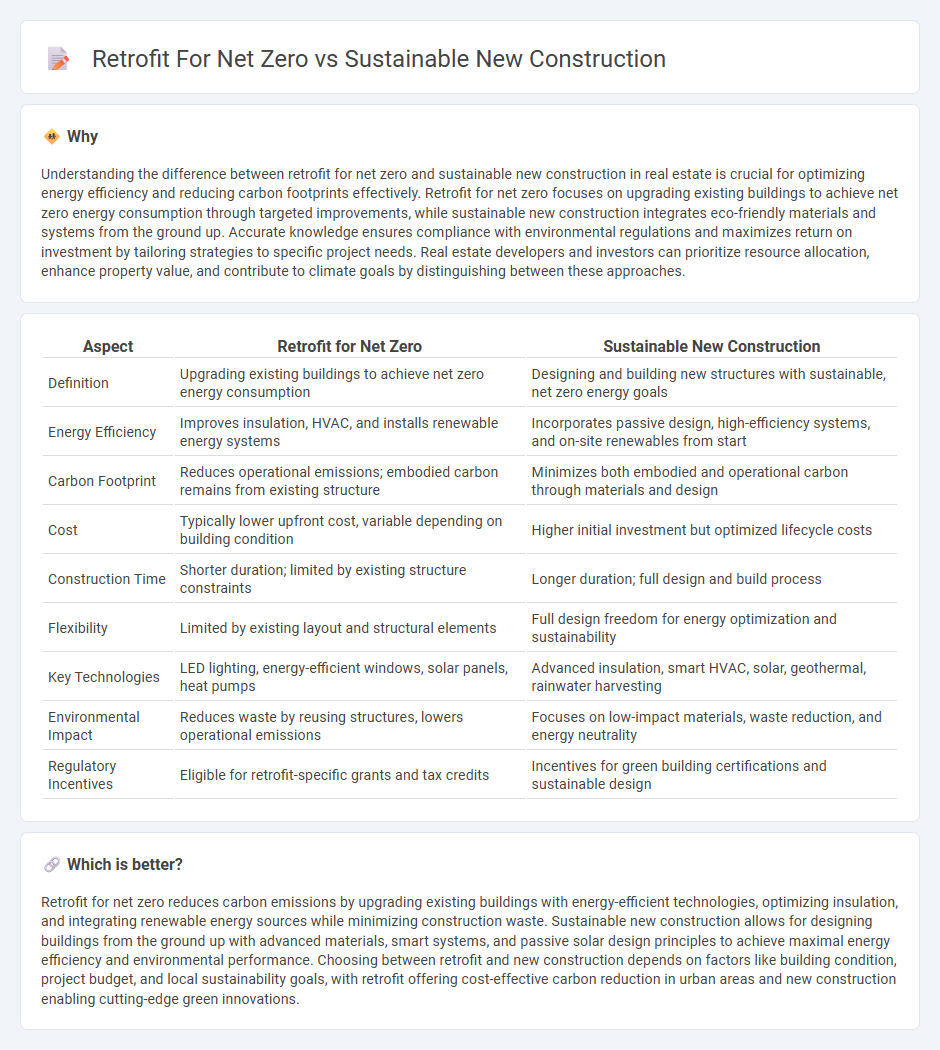
Retrofit for net zero focuses on upgrading existing buildings with energy-efficient technologies to drastically reduce carbon emissions and achieve net-zero energy consumption. Sustainable new construction incorporates eco-friendly materials, renewable energy systems, and smart design principles from the ground up to minimize environmental impact throughout the building's lifecycle. Explore further to understand the benefits and challenges of each approach in transforming real estate toward sustainability.
Why it is important
Understanding the difference between retrofit for net zero and sustainable new construction in real estate is crucial for optimizing energy efficiency and reducing carbon footprints effectively. Retrofit for net zero focuses on upgrading existing buildings to achieve net zero energy consumption through targeted improvements, while sustainable new construction integrates eco-friendly materials and systems from the ground up. Accurate knowledge ensures compliance with environmental regulations and maximizes return on investment by tailoring strategies to specific project needs. Real estate developers and investors can prioritize resource allocation, enhance property value, and contribute to climate goals by distinguishing between these approaches.
Comparison Table
| Aspect | Retrofit for Net Zero | Sustainable New Construction |
|---|---|---|
| Definition | Upgrading existing buildings to achieve net zero energy consumption | Designing and building new structures with sustainable, net zero energy goals |
| Energy Efficiency | Improves insulation, HVAC, and installs renewable energy systems | Incorporates passive design, high-efficiency systems, and on-site renewables from start |
| Carbon Footprint | Reduces operational emissions; embodied carbon remains from existing structure | Minimizes both embodied and operational carbon through materials and design |
| Cost | Typically lower upfront cost, variable depending on building condition | Higher initial investment but optimized lifecycle costs |
| Construction Time | Shorter duration; limited by existing structure constraints | Longer duration; full design and build process |
| Flexibility | Limited by existing layout and structural elements | Full design freedom for energy optimization and sustainability |
| Key Technologies | LED lighting, energy-efficient windows, solar panels, heat pumps | Advanced insulation, smart HVAC, solar, geothermal, rainwater harvesting |
| Environmental Impact | Reduces waste by reusing structures, lowers operational emissions | Focuses on low-impact materials, waste reduction, and energy neutrality |
| Regulatory Incentives | Eligible for retrofit-specific grants and tax credits | Incentives for green building certifications and sustainable design |
Which is better?
Retrofit for net zero reduces carbon emissions by upgrading existing buildings with energy-efficient technologies, optimizing insulation, and integrating renewable energy sources while minimizing construction waste. Sustainable new construction allows for designing buildings from the ground up with advanced materials, smart systems, and passive solar design principles to achieve maximal energy efficiency and environmental performance. Choosing between retrofit and new construction depends on factors like building condition, project budget, and local sustainability goals, with retrofit offering cost-effective carbon reduction in urban areas and new construction enabling cutting-edge green innovations.
Connection
Retrofitting existing buildings for net zero energy involves upgrading insulation, HVAC systems, and renewable energy installations, which directly informs sustainable new construction practices by setting performance benchmarks. Sustainable new construction incorporates these retrofit principles from the design phase, emphasizing energy efficiency, reduced carbon footprints, and the use of sustainable materials. Both approaches are integral to achieving carbon neutrality in real estate by minimizing operational energy use and promoting long-term environmental resilience.
Key Terms
Energy Efficiency
New construction designed for net zero energy performance incorporates advanced insulation, high-performance windows, and integrated renewable energy systems from the outset, resulting in greater efficiency and lower operational costs. Retrofit projects must overcome existing design limitations but can significantly reduce energy consumption by upgrading HVAC systems, enhancing building envelopes, and installing smart controls. Explore detailed strategies to optimize energy efficiency in net zero buildings.
Building Envelope
Sustainable new construction offers the advantage of designing a high-performance building envelope from the ground up, incorporating advanced insulation, airtight materials, and energy-efficient windows to achieve net zero energy goals. Retrofits focus on upgrading existing envelopes by adding insulation, sealing air leaks, and replacing outdated windows, which can significantly improve energy efficiency but may face limitations due to original building design constraints. Explore detailed strategies and case studies to determine the most effective approach for achieving net zero through building envelope enhancements.
Renewable Energy Systems
Integrating renewable energy systems in new sustainable construction offers optimized efficiency through seamless design, such as incorporating solar panels and geothermal heating from the outset. Retrofit projects face challenges like limited structural capacity and higher installation costs for upgrading existing buildings with renewable technologies. Explore how strategic renewable energy integration can decisively impact net zero goals by learning more about innovative construction and retrofit solutions.
Source and External Links
Green Globes for New Construction - Green Building Initiative - Green Globes NC is an environmental rating system for new construction that promotes sustainability by reducing carbon emissions, improving energy savings, and enhancing tenant health and resilience, supported by a consensus-based ANSI standard for integrated sustainable design.
Sustainability Guidelines - Homes and Community Renewal - NY.gov - New construction sustainability guidelines in New York focus on reducing greenhouse gas emissions by improving building envelope performance and electrifying heating and hot water systems to meet state climate goals, while ensuring quality and durability in affordable housing.
21 Construction Techniques to Build a Small, Sustainable, Eco-Friendly Home - Sustainable new construction techniques include passive solar design, insulated concrete forms (ICF) for energy efficiency and durability, landscaping, and other principles that optimize energy, water, material efficiency, and indoor environmental quality for eco-friendly homes.
 dowidth.com
dowidth.com